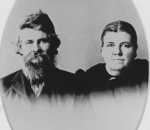Indians, 1872
Monday, January 23, 2012

Russell and Fidelia Loomis, Parents of Mary Loomis McDonald
Between 1860 and 1878 there were some 15 million buffalo that roamed the Great Plains. The territory between the Platte and Republican rivers was said to be the best buffalo hunting country in the world.
To the Plains Indians the buffalo was truly "the staff of life," and they prided themselves on the fact that they killed only as many buffalo as they needed to live. The buffalo fulfilled many needs for the Indians. The meat was dried in the summer for the winter's fare. The hides were tanned by the women for clothing, coverings for tepees -- and the travois, when hides stretched over two poles and pulled behind a horse, the equivalent of an Indian Pick-up truck.
Boats were made of buffalo hides stretched over willow boughs -- bags were fashioned for carting about their belongings, and hides were used for quivers for arrows, leggings and armlets for protection from the rebound of the bow string. Bow strings, whips, lariats, knife shields, papoose cradles were all made from buffalo hide. The sinews, from the buffalo's back, were dried and became thread, with which to sew moccasins and other garments. Buffalo hair was used to stuff pillows, and the brains of the animal were used in the tanning of the hides. Even the tail of the buffalo was used -- tied on the end of a stick, it made a fair brush.
Buffalo hides were used for beds, buffalo tallow was used in cooking and mixed with ochre and blood to make paint. The horns made fine decorations for war bonnets, and also became spoons and ladles. Buffalo bones were made into implements for dressing the hides. Shoulder blades, attached to long sticks and sharpened, made workable hoes and axes. Cooking the marrow from the ribs made glue, for attaching arrow heads to the arrows.
Evidently the Indians had some use for the paunch of the animals because Mary remembered seeing these carried on the ponies of the Indians that visited the Loomis homestead. And, of course, buffalo chips provided the fuel for fire on the near treeless prairie. Considering the importance of the buffalo to the Plains Indians, it is no wonder that they so much resented the loss of their hunting grounds to the whites, soldiers, hunters and settlers alike.
While the settlers freely used the buffalo as a major meat source, Mary Loomis believed that the settlers also never slaughtered the buffalo needlessly. However, after 1872, buffalo hunters began slaying the animals by the tens of thousands, reducing the population to near zero by the turn of the century, when men like Buffalo Jones, of McCook and Garden City, and Scotty Phillips in South Dakota, were credited with saving an entire species from extinction.
Those hunters killed the animals just for their hides, leaving carcasses scattered over the plains, food for the coyotes and buzzards. One hunter alone made $3,000 in one year selling buffalo hides, at the rate of $3 for a bull hide, $2 for a cow hide and 70 cents for a calf hide.
After that, needy pioneers spread over the prairie, gathering buffalo bones, which were sold for fertilizer, at a price of $4-$9 per ton. It took a man about 10 days to gather and market a wagonload of bones. At every railroad siding, huge piles of bones, some of them hundreds of feet long, awaited shipment.
The first summer (1872) that the Russell Loomis family spent along the Red Willow Creek north of present day McCook, was an exciting period in their lives. That summer, Pawnee Indians left their reservation, near Genoa, Nebraska, making their annual buffalo hunting trip, camping south of the Republican, directly across from where most of the settlers were located.
Across the river from the Indians a company of soldiers camped for the protection of the settlers. They lived in tents and dugouts, and had established their own little settlement. That summer, the soldiers made regular trips to North Platte to carry mail for the settlers. In the fall, after the Indians returned to Genoa, and the soldiers left, Mr. Loomis and other settlers scoured the area around the Army's rifle range for lead, which they melted and molded into bullets for their own rifles, which they carried in small leather pouches, attached to their saddles.
While the Pawnees were camped along the river, Mary's father, Russell, and her Uncle Heman visited their camp, which they found smelly, but interesting. While they were there they met Buffalo Bill and Texas Jack, who regularly spent time with friendly Indians.
Of the Indians that the Loomis family encountered, the Pawnee were the most common. They were, for the most part, friendly. The Sioux, who generally stayed north of the Republican Valley, visited this area less often, and were greatly feared.
While the buffalo hunts supplied the settlers with plenty of fresh meat, which they appreciated, the buffalo herds also brought Indians, and that sometimes meant trouble for the settlers. One day, Mary's Uncle Heman and her father set out to hunt buffalo. They had been gone but a short time when they returned, in the company of two very large Indians. The children were badly frightened, but the Indians were friendly and tried to make conversation. The children would have none of it and were amazed by their visitors -- the long black greasy hair, their dress, (or lack of it, as the Indians wore only breech cloths, moccasins on their feet, and a blanket thrown over one shoulder.)
The Indians and the Loomis men sat in a circle and one of the Indians complained of the mosquitos, saying "Heap Skeets," then he brought out a pipe and dried leaves, and the men smoked, keeping the mosquitos, which were especially bad that year, at bay.
When Mrs. Loomis and the children joined Russell on the homestead, one of their first chores had been to plant a garden. At that time, vegetables were unavailable for eight months out of the year, so the garden, even though small, was very important to the family.
They were all very proud of the garden and looked forward to enjoying their very own fresh vegetables.
When the Indians had finished their smoke they made their way to Mrs. Loomis' garden and freely helped themselves to the precious vegetables, and Mr. Loomis and Uncle Heman, having heard the stories of ferocious Indians, dared not to cross them. Those Indians must have had galvanized stomachs as they gorged themselves on green melons, squash and corn. When they could hold no more they grunted and walked away as if it had been their own garden they plundered. Mr. and Mrs. Loomis were so relieved that they had not been harmed that they soon forgot about the garden that they had so carefully tended.
To add insult to injury, the next day 12 Indians came riding into the Loomis yard. They were returning to the reservation at Genoa from their annual buffalo hunt and their ponies staggered under the weight of the buffalo meat they were carrying. Without a word they staked out their horses in the front yard and made a bee-line to what was left of the tiny garden. They gathered up what they could carry and proceeded to wolf down the produce right in front of the family. Again, the men could only watch the destruction of their winter's food supply.
When the Indian visitors had gorged themselves on the green vegetables they loaded the buffalo meat back on their little ponies. Most of them carried a whole buffalo, which was almost as big as the pony itself. Then astride the buffalo meat sat the Indian buck. What a sight they made as they rode off down the divide.
Mrs. Loomis did have a bit of satisfaction from this encounter however. One of the Indians had spied a jug through the open kitchen door. "Fire water?" he asked. Mrs. Loomis replied in the negative. The fellow was not convinced and confiscated the jug. It was vinegar.
Source: Prairie Schooner Days, A Story of Pioneer Life in Southwest Nebraska, by Mary Loomis McDonald

